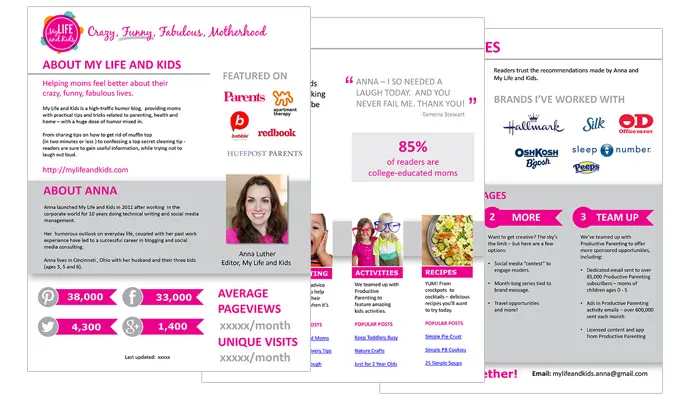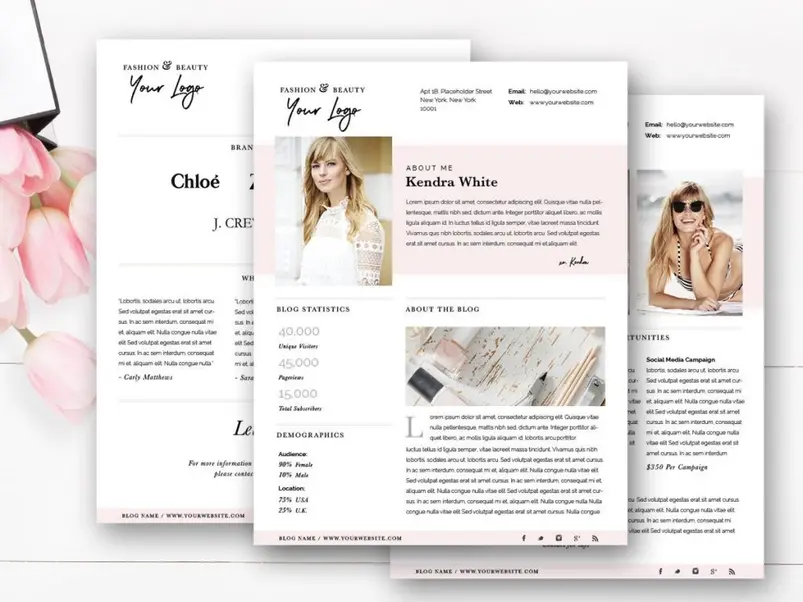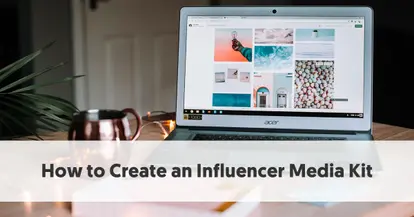One of the easiest ways to know that people consider you an influencer is when you receive your first request for an influencer media kit. All too often potential social media influencers are unprepared and don’t realize the need to have a media kit.
In reality, an influencer media kit is essential for any creative who finds success online, whether it is through social media, their blog site, a photographic website, or even on a public site such as Medium. If you produce quality content that attracts the attention of people, the odds are that in time people will come to think of you as an influencer. By having an influencer media kit on hand, you are prepared for that moment.
Once you have built success online, you will come to use your influencer media kit more regularly. Indeed, it is a vital document for any dedicated influencer.
Why Have an Influencer Media Kit?
You will probably be surprised the first time that a brand emails you, sounding you out with possibilities for influencer work. You might never have thought of yourself as an influencer. Quite a few brands use influencer platforms to identify potential influencers and many of these use algorithms to determine influencers in various niches. Indeed, in very narrow fields, you don’t even need particularly many followers for people to consider you influential.
Even nano-influencers with fewer than 1,000 followers are growing in popularity with brands because they often have a laser-like focus on their particular niche.
Once your social presence begins to grow, you should consider what you have to offer potential sponsors. If a brand came to you, what kinds of services could you provide them?
Most brands begin the process by requesting a media pack from the influencers they have identified and approached. They genuinely want to know how good a fit you would be with their target market.
Of course, some influencers prefer to work the other way. They first create an influencer media pack, detailing who they are, whom they target, and what they can offer brands. They then distribute their media pack to any business that appears to be congruent with their audience.
In many ways an influencer media kit is a modern version of an influencer’s CV – just it focuses on their online content creation rather than the jobs they have performed.
How to Create Your Influencer Media Kit – The Importance of Design
Your influencer media kit is an insight into your online personality. It is where you sell your skills as a knowledgeable social and/or blogging online commentator. Therefore, it needs to look professional and match your style.

Source: blogclarity.com
If you have access to Photoshop or InDesign use these to create a professional-looking document. A good alternative for the more budget-conscious is Canva.
You need to keep your media kit brief; ideally, limit it to three pages. Include a headshot of yourself and key imagery from your social channels. If you have used consistent colors, typography, and images on your social sites, continue the theme through to your influencer media kit.
Avoid clutter – leave plenty of white space around your writing and images. You need to be succinct in your copy and avoid embellishment. In the case of statistics, round your numbers where it is unlikely to make a difference in decision-making. If you have 10,462 followers, it looks better if you say you have 10K followers. However, don’t skimp on the number of metrics you show.
Your imagery and design are particularly important if you include photography amongst your services, or focus on a visual network, such as Instagram or Pinterest. People will take a quick look at your influencer media kit and decide on whether they like your design/photography skills before they even read it.
Items to Include in Your Influencer Media Kit
Important Details About Yourself
Potential brands and marketers are going to want to know a little about you. Don’t go into every little detail of your life, however. Summarize yourself in a few sentences, emphasizing your expertise in whatever niche that is the focus of your blog and/or social activity.
It helps brands to understand the type of person they could potentially work alongside.
In particular, brands want to ensure that their partnering influencers align with their corporate values. Be honest in your About section. Ensure that you come across as the same person who people recognize as being influential online.
Explain why you are passionate about your niche. If you write about life skills, explain why. What are your goals? Why do you believe that people value your posts?
The better a brand or marketer knows you, the more successful the relationship with a sponsor will be.
Your Contact Details
There is little point in creating an influencer media kit if interested people can’t make contact with you.
You need accurate and up-to-date contact information. At a minimum include your email address, website, and social handles. Ideally, you should add your phone number and postal address as well.
Follower Numbers on Your Important Social Networks
While brands now recognize that there is much more to social success than mere follower numbers, they still want to ensure that you do influence people. You should include follower numbers for every one of your active social media accounts.
This gives potential sponsors a good idea of where you are active and where you have your greatest popularity. They need to be able to determine whether you will make a good match for their goals and whether you attract the same type of following as their intended target audience. For example, a brand selling garden furniture to middle-aged homemakers is unlikely to invest much in an influencer who has made their name on Snapchat.
Important Website / Blog Statistics
Although some influencers solely make their name on social media, many others also have a website. Your main area of influence may be via your blog, for example.
You should use Google Analytics (or a paid alternative) to gather essential metrics indicating your website’s performance. As well as showing marketers the quality of your site, this also signposts that you are organized enough to know the importance of website statistics.

Source: etsy.com
You should include the main metrics relating to your site. This includes your monthly unique visitors, monthly page views, and the average duration of their visit. You should also include your site’s Bounce Rate. You might even add some relevant stats relating to the demographics your site attracts.
If you have a sizeable email list, include your number of email subscribers, too.
Audience Demographics
In some ways, this is the most essential part of your influencer media kit. Ultimately, brands and marketers are looking for influencers who have a group of followers that closely match their own target market. There is little point a brand working with an influencer, even a highly popular one if their followers and the brand’s target market are a mismatch.
While you obviously have to restrict the detail you provide, to avoid cluttering your influencer media kit, you need to describe succinctly the kinds of people who choose to follow you. Obviously, your niche is essential here.
You want to sum up your typical followers – their gender and age range, as well as the countries that provide your your greatest support. If most of your supporters live in a nation that provides regional data, such as USA states, you could break down your following even more granularly.
The best influencer relationships occur when a brand’s customer demographics align closely with an influencer’s audience demographics.
Past Work and Current Partnerships
If you have already started some influencer marketing, you will have built up a selection of “clips” – previous posts you have made on behalf of clients. Refer to some of your better influencer work in your kit. Include any relevant illustrations to make your point.
You could even include samples of your social posts to give potential clients an indication of the type of work your produce.
Testimonials
Experienced influencers can also include testimonials from past brands with whom they have collaborated. There is nothing better than social proof to encourage firms to work with you. Testimonials can help separate your media kit from those of less experienced and successful influencers.
Be honest here, though. Only include real, unsolicited testimonials. It is easy for people to check the legitimacy of testimonials, and you don’t want to be left embarrassed because of any dishonest actions.
Suggested Collaboration Options
This can be tricky for the beginner influencer. You need to decide what you are prepared to offer to sponsor brands. Ideally, you should be as specific as possible here, although again this will be easier if you have past paid influencer experience.
For instance, if you’re a blogger, you may offer to write a dedicated sponsored post, exclusively featuring the client’s brand.
Alternatively, you may offer to mention the client’s product in a shared blog post.
Instagram influencers could offer similar services. For example, you may suggest you create an image of you using a client’s product, extolling its virtues in the comments. Alternatively, you may create a more guerrilla post, where you merely wear the sponsor’s product in a photograph, while you do an unrelated activity.
You could also offer extra, such as running a competition on behalf of a brand, sponsoring a product giveaway, or giving your followers a promo code for the sponsor’s product.
There are many other ways you can work with brands, depending on your choice of social media and the medium you use. For instance, you could formally review their product, interview somebody at the company, or create a stylistic photo shoot based on the product.
Your Pricing Rates
When you first realize that people consider you an influencer it may be difficult to decide on payment rates. There is no centralized scale that you can follow. Indeed, many influencers begin their careers with firms paying them with free products, rather than with money.
However, once you’re comfortable with the idea of charging for your sponsored posts, you will find it easier to charge brands money for work you do on their behalf. At this point, you have to decide what you are worth. Existing influencers charge brand rates ranging from $50 to $250,000, depending on factors like the number of views, typical engagements, and the “importance” of the influencers.
PMYB suggests six factors that can affect an influencer’s pricing rates:
- Reach, platform, and volume of genuine engagement
- The audience quality of an influencer
- The expertise level of the influencer
- The quality of the content the influencer shares
- How well an influencer fits in with your brand
- Earned Media Value of the influencer’s posts
It will be hard to set rates in your early days, however, the more contracts that you have with brands; the easier it is to determine your worth.
While you may be reluctant to commit yourself in your influencer media kit, it at least indicates that you are genuine. It also gives potential sponsors a general idea of the level of payment you expect and means that brands with small budgets don’t waste time trying to connect to influencers who are well outside what they can afford.
Avoid phrases like “starting at” in your kit. That simply tells potential collaborators what your bottom line is. They know they can always negotiate you down to your starting figure.
The other reason to show rates is that it makes it clear to people that you are serious. They can’t expect you to promote them “as a favor” or in return for a small amount of free product.
You could combine the Suggested Collaboration Options with the Rates and Pricing section of your media kit. Here you would list your suggested services, with your price beside each service.
Whether you should include your prices in your influencer media kit is a polarizing point amongst influencers. Some people firmly believe that it is not the correct place to list them. The alternative approach is to place them in any proposal you send with your kit to people who have already expressed an interest in your services. This means that you can tailor a single price for the particular combination of services you offer them.
Of course, be prepared to negotiate, particularly if a brand or marketer comes up with an atypical combination of services for a particular influencer campaign.
What should you do With Your Influencer Media Kit?
There are two main ways that you can use your influencer media kit. You can make it available for anybody who approaches you about a potential partnership, or you can proactively send it out to businesses, marketers, and even journalists.
If you choose to send, your influencer media kit out be selective about the types of people to whom you target. It is as important to you to ensure that there is influencer-brand alignment, as it is to a brand. There is little point sending your influencer media kit to businesses that are irrelevant to your niche, or apparently have different values to your own.
Also, you need to ensure that your email doesn’t appear like spam. You need to personalize it; so that it doesn’t look like part of a mass mailing. If possible, research the correct person in each organization to whom you should make the initial approach.
Frequently Asked Questions
What is an influencer media kit?
An influencer media kit is a document that showcases an influencer's skills, audience, and previous collaborations to potential brand partners. It serves as a digital resume highlighting the influencer's value proposition.
Why is an influencer media kit important?
An influencer media kit is essential for any online creator looking to secure brand partnerships. It demonstrates professionalism, communicates key metrics efficiently, and helps align the influencer's personal brand with suitable collaborations.
What should be included in an influencer media kit?
A winning influencer media kit typically includes:
- A bio and contact details
- Follower counts on key social networks
- Audience demographics and engagement rates
- Examples of past collaborations and content
- Collaboration opportunities and pricing
How long should an influencer media kit be?
It's best to keep your influencer media kit concise, ideally limited to 3 pages. Focus on highlighting the most important and compelling information in a visually appealing way.
What design elements are important for an influencer media kit?
The design of your influencer media kit should reflect your personal brand. Use consistent colors, typography, and imagery that matches your social media presence. Include a headshot and key visuals from your content.
How do I gather data for my influencer media kit?
Use native analytics or social media management tools to collect follower counts, engagement rates, and other performance metrics for your active platforms. For websites, utilize Google Analytics to report traffic data.
Should I include past collaboration examples in my media kit?
Yes, showcasing successful past collaborations and results is a great way to demonstrate your value to potential partners. Include relevant metrics like post views, link clicks, and conversions.
How do I write an effective bio for my influencer media kit?
Your bio should be a short, compelling summary of your background, content focus, and expertise. Mention any relevant awards, media features, or credentials that establish your authority in your niche.



![What is an Influencer? – Social Media Influencers Defined [Updated 2025]](https://s.influencermarketinghub.com/imaginary/resize?width=400&height=200&type=webp&url=https://influencermarketinghub.com/wp-content/uploads/2017/03/What-is-an-Influencer.png)
